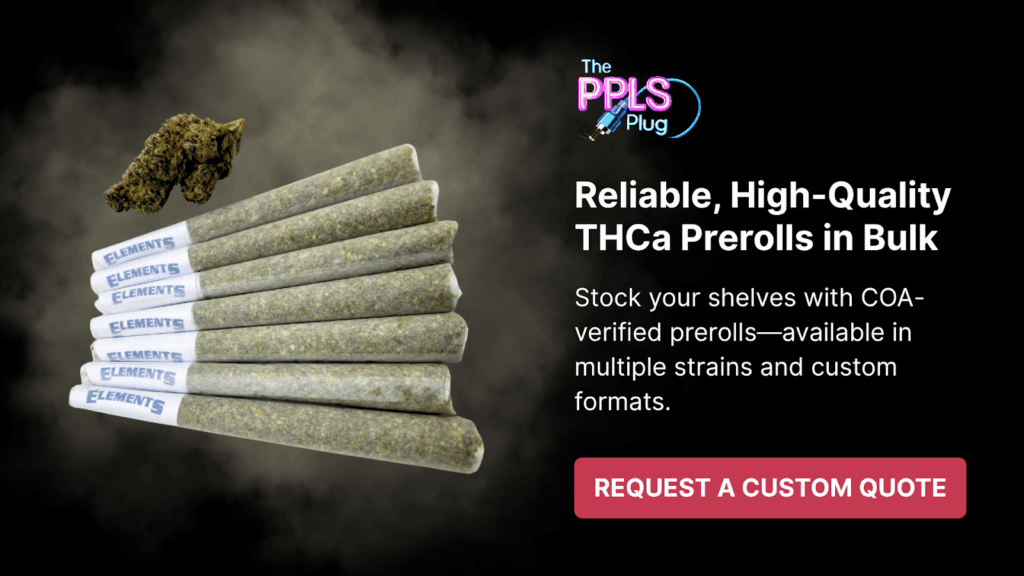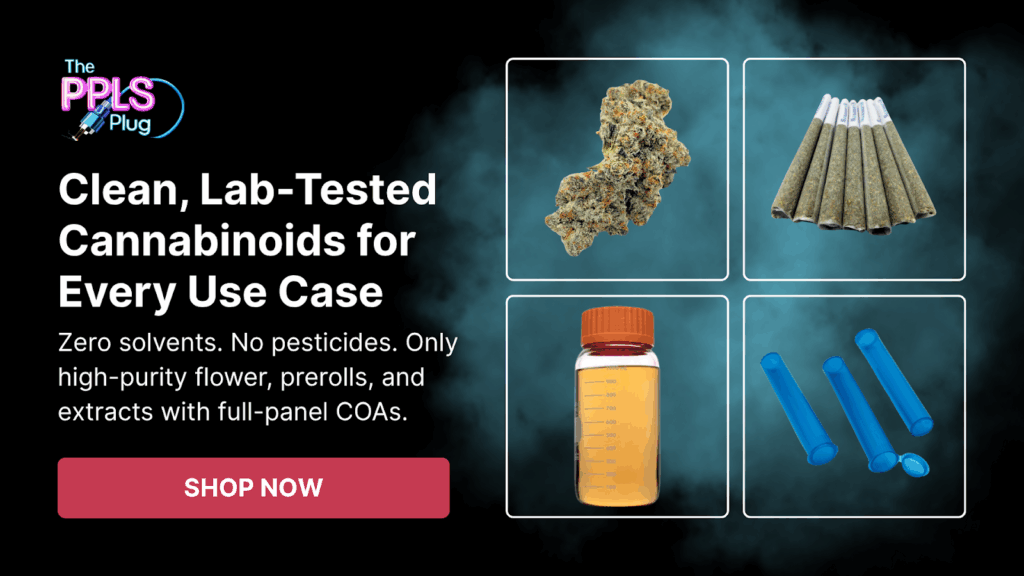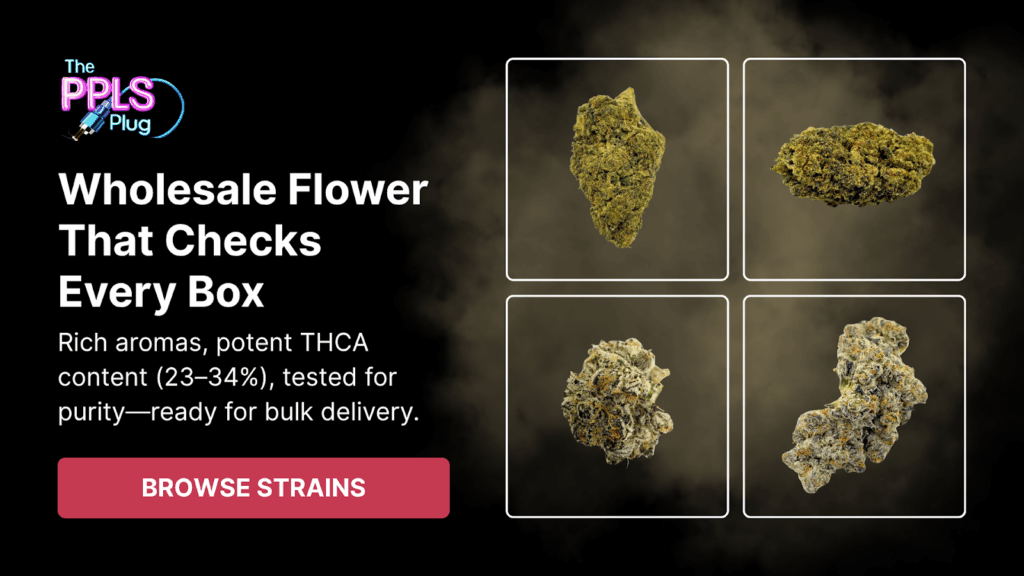Understanding THCA Detection: What To Know Before A Drug Test
Key Takeaways:
- Conversion: THCA can change into Delta-9 THC when heated, creating metabolites that appear on drug tests.
- Testing: Different screenings show THCA for hours, days, or even months depending on method.
- Influences: Frequency of use, metabolism, and lifestyle all affect how long THCA stays in the system.
Understanding how long THCA stays in the body is a concern for many hemp users. People want to know how it moves through their system, what makes detection vary, and how tests may pick it up. By breaking down these details, we can give clarity to a topic that often leaves consumers uncertain.
At The PPLs Plug, we set the standard in hemp wholesale by providing premium THCA flower, concentrates, and pre-rolls at competitive prices. Every product is backed by third-party lab testing to confirm quality and compliance, giving our customers reliable options in bulk, wholesale, and exotic varieties.
How THCA Moves Through The Body
THCA, or tetrahydrocannabinolic acid, is the raw, non-psychoactive form of THC that naturally occurs in hemp. On its own, it does not create intoxicating effects. However, once it is exposed to heat during smoking, vaping, or cooking, THCA transforms into Delta-9 THC through a process known as decarboxylation. Delta-9 THC is the compound that most drug tests are designed to detect.
When consumed in raw form, such as in unheated flower or fresh extracts, THCA may remain in its acidic state. Even so, studies indicate that the body can still process some of it into detectable metabolites. These byproducts, known as THC-COOH, are what standard screenings identify in blood, urine, or saliva.
This process means that anyone consuming THCA products should understand that the compound may still be picked up during testing. Choosing bulk THCA flower or wholesale selections from The PPLs Plug provides clarity, since all products come with verified cannabinoid profiles and are sourced to meet high standards.
For those seeking larger quantities, THCA flower by the pound and exotic THCA flower wholesale options are available, giving customers confidence in both quality and consistency.
Factors That Affect How Long THCA Stays In Your System
How long THCA remains detectable is not the same for everyone. A variety of personal habits, body characteristics, and testing methods can influence the timeframe. Below are the main factors that play a role in determining detection windows:
Frequency And Amount Of Use
Those who consume THCA occasionally may find that it leaves the body faster compared to heavy or daily users. Regular use allows cannabinoids to accumulate in fat cells, extending how long they can be detected. Larger servings of THCA flower in bulk or wholesale purchases can lengthen the detection window significantly.
Body Composition And Metabolism
Everyone processes cannabinoids at a different pace. Individuals with higher body fat percentages tend to retain THCA byproducts for longer periods since cannabinoids are fat-soluble. A faster metabolism, influenced by age, activity level, and diet, may help clear compounds more quickly.
Choosing Reliable THCA Products
For customers who want dependable options, The PPLs Plug offers THCA flower by the pound and exotic THCA flower wholesale, both paired with lab reports to help you better understand what you are consuming. This level of transparency allows buyers to track potency, cannabinoid content, and overall product quality. Reliable sourcing is just as important as understanding detection times, since it ensures you know what is entering your system.
Type Of Test Used
Not every drug screening works the same way. Urine tests are the most common and can detect byproducts for days or weeks, while blood and saliva tests usually reveal use within a shorter timeframe. Hair follicle tests may pick up cannabinoid exposure for months, although they are less common.
Hydration And Lifestyle Choices
Staying hydrated and maintaining an active lifestyle may support the body’s natural detoxification process. While water intake does not guarantee quicker elimination, it may assist in maintaining balance within metabolic systems. Consistent physical activity can also influence how quickly THCA metabolites are processed and released.
Detection Windows Based On Test Type
THCA can be detected in the body for varying lengths of time depending on the method of testing. Each type of screening has its own level of sensitivity and timeframe. Here is what you should know about the most common tests:
Urine Screenings
Urine tests are the most frequently used method for identifying cannabinoid use. Occasional users may test positive for one to three days, while consistent or heavy users could see results lasting up to thirty days or more. Factors like hydration, body composition, and frequency of use all influence how long THCA metabolites linger.
Blood Analysis
Blood tests measure cannabinoids currently circulating in the bloodstream. THCA and its byproducts typically remain detectable for only a few hours up to a couple of days. This makes blood analysis more suitable for identifying recent use rather than long-term patterns.
Saliva Swabs
Saliva testing is quick and less invasive than other methods. Cannabinoid traces may be detected for twenty-four to seventy-two hours depending on frequency of use and the sensitivity of the testing equipment. Saliva swabs are often used in roadside checks or immediate screening situations.
Hair Follicle Tests
Hair follicle analysis provides the longest detection window. Because cannabinoids can be embedded in hair as it grows, traces of THCA use may be detected for up to ninety days or longer. However, this method is less effective at identifying very recent use since it takes about a week for new hair to capture metabolites.
Comparing THCA And THC In Drug Testing
THCA and THC are closely related but behave differently when it comes to both effects and detection. Understanding these distinctions is important for anyone who may face a screening, since both compounds can appear in results depending on how they are consumed.
Molecular Differences Between THCA And THC
THCA is the acidic, non-psychoactive form of THC that is found in raw hemp flower. It does not produce intoxicating effects until it undergoes decarboxylation, the process triggered by heat that converts it into Delta-9 THC. Once converted, Delta-9 THC interacts with the body in ways that standard drug tests are designed to detect.
How Tests Identify Each Compound
Most drug screenings do not look directly for THCA. Instead, they identify the metabolites that result after the body processes Delta-9 THC, primarily THC-COOH. However, because THCA can convert into Delta-9 THC during consumption, those who use wholesale THCA flower or exotic strains may still test positive even if they started with a non-psychoactive product.
Overlapping Detection Windows
The detection timeline for THCA can mirror that of THC if the compound is heated before or during use. This means the duration it stays in the body depends not only on the compound itself but also on how it is consumed. Customers purchasing THCA flower by the pound from The PPLs Plug should keep this in mind when planning around possible screenings.
Practical Tips If You Have An Upcoming Test
For anyone preparing for a screening, being aware of how long THCA may stay in the body can make a difference. While there is no guaranteed way to control results, there are practical steps that may help support the body’s natural processes and set expectations more realistically.
Stay Consistently Hydrated
Drinking water regularly supports overall health and helps the body carry out its natural detoxification functions. While it does not instantly clear THCA or its metabolites, maintaining hydration may contribute to balanced metabolic activity.
Know The Type Of Test
Each test varies in how long it can detect cannabinoids. Urine screenings often reveal use for several days or weeks, while blood and saliva tests typically have shorter detection periods. Hair follicle testing may capture use over months, which is important for long-term planning.
Consider Frequency And Amount Of Use
Someone who consumes THCA once in a while may clear it faster compared to someone who uses it daily or in large quantities. Recognizing your own consumption habits is an important step in estimating detection time.
Support Your Metabolism
Healthy lifestyle choices such as physical activity, balanced nutrition, and sufficient rest may help the body process cannabinoids more effectively. These habits influence how long THCA byproducts remain detectable.
Use Trusted Products
The quality of the product consumed also matters. With bulk THCA flower and exotic THCA flower wholesale from The PPLs Plug, customers have access to lab-tested options that provide accurate cannabinoid profiles. This transparency helps in understanding exactly what enters the body.
Final Insights
THCA may not be psychoactive in its raw form, but the way the body processes it can still produce detectable metabolites that show up on screenings. The length of time it remains in your system depends on how often you consume it, your metabolism, and the type of test being used.
For individuals who want to enjoy hemp products while staying informed, The PPLs Plug offers a variety of trusted options. From THCA flower by the pound to wholesale bulk selections and exotic strains, every product is paired with lab testing to ensure clarity and quality.
By understanding detection timelines and choosing products backed by transparent reports, customers can approach their hemp use with greater awareness.
Frequently Asked Questions About How Long THCA Stays In Your System
Can secondhand smoke from THCA cause a positive test result?
While it is less likely, being in a space with heavy THCA smoke could expose you to small amounts of THC metabolites. Sensitive tests might detect this exposure in rare cases.
Does eating THCA-infused edibles change detection times compared to smoking?
Yes. When eaten, THCA passes through the digestive system and liver, which can extend how long metabolites stay in your body compared to inhalation.
Is it possible for THCA to build up in the body over time?
Regular use can cause cannabinoids to accumulate in fat cells. This storage can make it harder for the body to eliminate THCA metabolites quickly.
Can exercise help reduce detection time for THCA?
Physical activity may influence metabolism and fat breakdown. However, it does not guarantee faster elimination of THCA byproducts.
Are detox products effective for clearing THCA from the body?
There is little scientific proof that detox products can clear cannabinoids quickly. The body primarily relies on natural metabolic processes to reduce levels.
How long can THCA stay in saliva after vaping?
Saliva tests may detect THCA metabolites for one to three days after vaping, depending on how much was consumed and the sensitivity of the test.
Do genetics influence how long THCA remains detectable?
Yes. Genetic differences in liver enzymes and metabolism can affect how quickly THCA is broken down and excreted from the body.
Can CBD products affect THCA detection times?
CBD itself does not convert to THC, but some products may contain small amounts of THCA or THC. Using mixed products could impact test results.
Are workplace tests more likely to detect THCA than athletic screenings?
Workplace tests often rely on urine analysis, which has longer detection windows. Athletic screenings may use saliva or blood tests, which are shorter in range.
Does drinking alcohol influence how long THCA stays in the system?
Alcohol can affect liver metabolism, potentially changing how the body processes cannabinoids. While not a major factor, it may slightly alter detection times.
Sources:
- Pavlic, M., Innerhofer, C., & Pitterl, F. (2025). Quantification of ∆9-tetrahydrocannabinol, 11-OH-THC, THC-COOH, hexahydrocannabinol, and cannabidiol in human plasma and blood by liquid chromatography–tandem mass spectrometry. Journal of Analytical Toxicology, 49(2), 85–95. https://doi.org/10.1093/jat/bkae094
- Huestis, M. A., Mitchell, J. M., & Cone, E. J. (1995). Urinary cannabinoid detection times following single and multiple doses of smoked marijuana. Journal of Analytical Toxicology, 19(6), 444–453. https://doi.org/10.1093/jat/19.6.443
- Reber, J. D., Karschner, E. L., Seither, J. Z., Knittel, J. L., Dozier, K. V., & Walterscheid, J. P. (2022). An Enhanced LC-MS-MS Technique for Distinguishing Δ8- and Δ9-Tetrahydrocannabinol Isomers in Blood and Urine Specimens. Journal of Analytical Toxicology, 46(4), 343–349. https://doi.org/10.1093/jat/bkac007
- Hastedt, M. (2014). R. C. Baselt (ed.): Disposition of toxic drugs and chemicals in man, 10th edition. Forensic Science, Medicine, and Pathology, 11(1), 147–147. https://doi.org/10.1007/s12024-014-9602-3
Latest Products
-
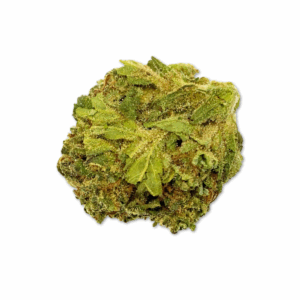 Rated 0 out of 5Select options This product has multiple variants. The options may be chosen on the product pageLog In to see prices
Rated 0 out of 5Select options This product has multiple variants. The options may be chosen on the product pageLog In to see prices -
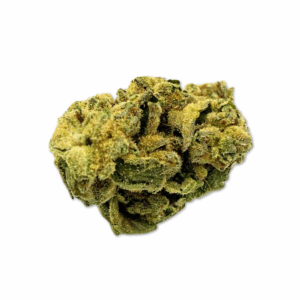 Rated 0 out of 5Select options This product has multiple variants. The options may be chosen on the product pageLog In to see prices
Rated 0 out of 5Select options This product has multiple variants. The options may be chosen on the product pageLog In to see prices -
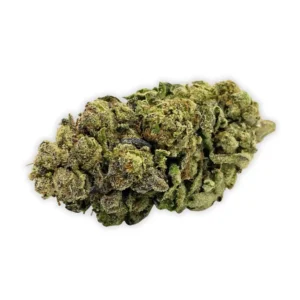 Rated 0 out of 5Out of stockSelect options This product has multiple variants. The options may be chosen on the product pageLog In to see prices
Rated 0 out of 5Out of stockSelect options This product has multiple variants. The options may be chosen on the product pageLog In to see prices -
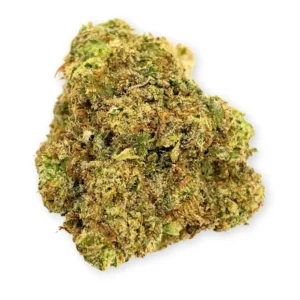 Rated 0 out of 5Out of stockSelect options This product has multiple variants. The options may be chosen on the product pageLog In to see prices
Rated 0 out of 5Out of stockSelect options This product has multiple variants. The options may be chosen on the product pageLog In to see prices

